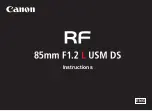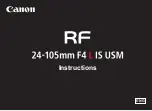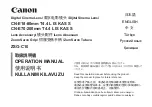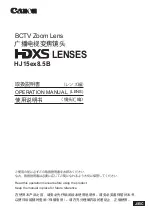
5
INTRODUCTION
Your eyes need oxygen to stay healthy and to keep you seeing well and feeling well. But, unlike all the other organs
of your body, your eyes do not rely on the blood for oxygen. Instead they receive oxygen directly for the air and
from the tears that continually bathe them. That’s why it is important that today’s contact lenses allow oxygen to
pass through them so that the oxygen in the air can reach the eye’s tissues. Just as importantly, contact lenses must
be fitted properly by an eye care professional so that they will allow and, in fact, promote the movement of oxygen-
rich tears around and underneath them.
Your eye care professional can prescribe FluoroPerm
®
/ HDS
®
rigid gas permeable contact lenses in a variety of
prescriptions and designs depending upon your vision correction needs. In addition, your eye care professional will
determine what type of wearing schedule is best suited for you.
PRECAUTIONS
Specific Precautions
•
Clinical studies have demonstrated that FluoroPerm
®
30 (paflufocon C), FluoroPerm
®
60 (paflufocon B),
FluoroPerm
®
92 (paflufocon A), FluoroPerm
®
151 (paflufocon D), Paragon HDS
®
(paflufocon B), Paragon
Thin
™
(paflufocon C), and Paragon HDS
®
100 (paflufocon D) rigid gas permeable contact lenses are safe and
effective for their intended use. Due to the small number of patients enrolled in clinical investigation of lenses,
all refractive powers, design configurations, or lens parameters available in the lens materials were not
evaluated in significant numbers. Consequently, when selecting an appropriate lens design and parameters, the
eye care practitioner must consider all factors that can affect lens performance and ocular health, including
oxygen permeability, wettability, central and peripheral thickness, and optic zone diameter. The potential
impact of these factors on the patient's ocular health must be carefully weighed against the patient's need for
refractive reduction; therefore, the continuing ocular health of the patient and lens performance on the eye
should be carefully monitored by the prescribing eye care practitioner.
•
Patients should be instructed to follow the instructions below in order to prevent damage to their eyes or lenses.
Solution Precautions
•
Different solutions cannot always be used together, and not all solutions are safe for use with all lenses. Use
only recommended solutions with FluoroPerm
®
/ HDS
®
contact lenses.
•
Do not heat the wetting/soaking solution and lenses.
•
Always use fresh unexpired lens care solutions.
•
Always follow directions in the package inserts of the contact lens solutions used.
•
Use only a chemical lens care system. Use of a heat (thermal) lens care system can cause damage by warping
FluoroPerm
®
/ HDS
®
contact lenses.
•
Sterile unpreserved solutions, when used, should be discarded after the time specified in the labeling directions.
•
Do not use saliva, tap water, or anything other than the recommended solutions for lubricating or wetting lenses.
•
Always keep the lenses completely immersed in the recommended storage solution when the lenses are not
being worn (stored).




























